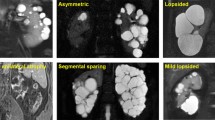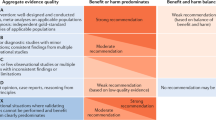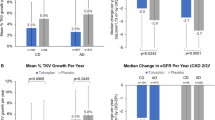Abstract
Autosomal dominant polycystic kidney disease (ADPKD) is characterized by the unrelenting enlargement of innumerable cysts derived from renal tubules. This cystic growth often leads to a grotesque renal enlargement. Relatively early in life, the cysts trigger secondary complications including pain, hypertension and gross hematuria; renal insufficiency is usually not detected until the fifth or sixth decade of life. Therapies targeted to molecular and pathophysiological abnormalities slow cyst growth and protect renal function in animal models of the disease. Unfortunately, the translation of these treatments into clinical trials is hampered since glomerular filtration rate, the usual biomarker of renal disease progression, does not decrease substantially until extensive and irreversible damage to noncystic parenchyma occurs. Ultrasonography, CT and MRI have been used for many years to quantify the increase in renal volume in patients with ADPKD. Imaging with these techniques has also been used to accurately quantify the rate of increased kidney and total cyst volume in patients. In this Review we discuss the overwhelming evidence in support of the view that imaging is an invaluable tool to monitor the onset and progression of ADPKD and is well-suited to gauge the response of this disease to targeted therapy before renal function begins to decline.
Key Points
-
In adult patients with autosomal dominant polycystic disease (ADPKD) and symmetrically enlarged kidneys, the magnitude of combined renal volume is a prognostic indicator of disease severity
-
Hypertension, gross hematuria and renal insufficiency seem to be linked to absolute kidney size and the rate of renal growth in patients with ADPKD
-
Imaging is an invaluable tool to monitor the progression of ADPKD and gauge response to targeted therapy in the early stages of disease
-
Ultrasonography is useful for screening individuals at risk of developing ADPKD or to follow changes over long periods of time
-
CT and MRI should be used to quantify renal volume increases over short intervals
-
Other quantitative imaging markers potentially associated with the progression of ADPKD include the size, number, spatial distribution, individual growth rate, and asymmetry of cysts
This is a preview of subscription content, access via your institution
Access options
Subscribe to this journal
Receive 12 print issues and online access
$209.00 per year
only $17.42 per issue
Buy this article
- Purchase on Springer Link
- Instant access to full article PDF
Prices may be subject to local taxes which are calculated during checkout








Similar content being viewed by others
References
Grantham, J. J. Clinical practice. Autosomal dominant polycystic kidney disease. N. Engl. J. Med. 359, 1477–1485 (2008).
Gabow, P. A. et al. Factors affecting the progression of renal disease in autosomal-dominant polycystic kidney disease. Kidney Int. 41, 1311–1319 (1992).
Grantham, J. J., Chapman, A. B. & Torres, V. E. Volume progression in autosomal dominant polycystic kidney disease: the major factor determining clinical outcomes. Clin. J. Am. Soc. Nephrol. 1, 148–157 (2006).
Grantham, J. J. et al. Volume progression in polycystic kidney disease. N. Engl. J. Med. 354, 2122–2130 (2006).
Klahr, S. et al. Dietary protein restriction, blood pressure control, and the progression of polycystic kidney disease. Modification of Diet in Renal Disease Study Group. J. Am. Soc. Nephrol. 5, 2037–2047 (1995).
Gregoire, J. R., Torres, V. E., Holley, K. E. & Farrow, G. M. Renal epithelial hyperplastic and neoplastic proliferation in autosomal dominant polycystic kidney disease. Am. J. Kidney Dis. 9, 27–38 (1987).
Harris, P. C. & Torres, V. E. Polycystic kidney disease. Annu. Rev. Med. 60, 321–337 (2009).
Gattone, V. H. 2nd, Maser, R. L., Tian, C., Rosenberg, J. M. & Branden, M. G. Developmental expression of urine concentration-associated genes and their altered expression in murine infantile-type polycystic kidney disease. Dev. Genet. 24, 309–318 (1999).
Gattone, V. H. 2nd, Wang, X., Harris, P. C. & Torres, V. E. Inhibition of renal cystic disease development and progression by a vasopressin V2 receptor antagonist. Nat. Med. 9, 1323–1326 (2003).
Torres, V. E. et al. Effective treatment of an orthologous model of autosomal dominant polycystic kidney disease. Nat. Med. 10, 363–364 (2004).
Wang, X., Gattone, V. 2nd, Harris, P. C. & Torres, V. E. Effectiveness of vasopressin V2 receptor antagonists OPC-31260 and OPC-41061 on polycystic kidney disease development in the PCK rat. J. Am. Soc. Nephrol. 16, 846–851 (2005).
Nagao, S. et al. Increased water intake decreases progression of polycystic kidney disease in the PCK rat. J. Am. Soc. Nephrol. 17, 2220–2227 (2006).
TEMPO 3/4 Trial” Tolvaptan Efficacy and Safety in Management of Polycystic Kidney Disease and Its Outcomes (TEMPO3/4) ClinicalTrials.gov A service of the U. S. National Institutes of Health [online], (2009).
Somatostatin in Polycystic Kidney: a Long-term Three Year Follow up Study ClinicalTrials.gov A service of the U. S. National Institutes of Health [online], (2009).
Octreotide in Severe Polycystic Liver Disease ClinicalTrials.gov A service of the U. S. National Institutes of Health [online], (2009).
Lanreotide as Treatment of Polycystic Livers (LOCKCYST) ClinicalTrials.gov A service of the U. S. National Institutes of Health [online], (2009).
Edelstein, C. L. Mammalian target of rapamycin and caspase inhibitors in polycystic kidney disease. Clin. J. Am. Soc. Nephrol. 3, 1219–1226 (2008).
Edelstein, C. L. Therapeutic interventions for autosomal dominant polycystic kidney disease. Nephrol. News Issues 22, 25–26 (2008).
Qian, Q. et al. Sirolimus reduces polycystic liver volume in ADPKD patients. J. Am. Soc. Nephrol. 19, 631–638 (2008).
Weimbs, T. Polycystic kidney disease and renal injury repair: common pathways, fluid flow, and the function of polycystin-1. Am. J. Physiol. Renal Physiol. 293, F1423–F1432 (2007).
Wu, M. et al. Everolimus retards cyst growth and preserves kidney function in a rodent model for polycystic kidney disease. Kidney Blood Press. Res. 30, 253–259 (2007).
Weimbs, T. Regulation of mTOR by polycystin-1: is polycystic kidney disease a case of futile repair? Cell Cycle 5, 2425–2429 (2006).
Pilot Study of Rapamycin as Treatment for Autosomal Dominant Polycystic Kidney Disease (ADPKD) ClinicalTrials.gov A service of the U. S. National Institutes of Health [online], (2006).
Sirolimus Treatment in Patients With Autosomal Dominant Polycystic Kidney Disease: Renal Efficacy and Safety (SIRENA) ClinicalTrials.gov A service of the U. S. National Institutes of Health [online], (2007).
Sirolimus (Rapamune®) for Autosomal Dominant Polycystic Kidney Disease (ADPKD) ClinicalTrials.gov A service of the U. S. National Institutes of Health [online], (2008).
Efficacy, Safety and Tolerability of Everolimus in Preventing End-Stage Renal Disease in Patients With Autosomal Dominant Polycystic Kidney Disease ClinicalTrials.gov A service of the U. S. National Institutes of Health [online], (2008).
Desai, P. J. et al. Bilateral laparoscopic nephrectomy for significantly enlarged polycystic kidneys: a technique to optimize outcome in the largest of specimens. BJU Int. 101, 1019–1023 (2008).
Parfrey, P. S. et al. The diagnosis and prognosis of autosomal dominant polycystic kidney disease. N. Engl. J. Med. 323, 1085–1090 (1990).
Ravine, D. et al. Evaluation of ultrasonographic diagnostic criteria for autosomal dominant polycystic kidney disease 1. Lancet 343, 824–827 (1994).
Bakker, J. et al. Renal volume measurements: accuracy and repeatability of US compared with that of MR imaging. Radiology 211, 623–628 (1999).
O'Neill, W. C. et al. Sonographic assessment of the severity and progression of autosomal dominant polycystic kidney disease: the Consortium of Renal Imaging Studies in Polycystic Kidney Disease (CRISP). Am. J. Kidney Dis. 46, 1058–1064 (2005).
Fick-Brosnahan, G. M., Belz, M. M., McFann, K. K., Johnson, A. M. & Schrier, R. W. Relationship between renal volume growth and renal function in autosomal dominant polycystic kidney disease: a longitudinal study. Am. J. Kidney Dis. 39, 1127–1134 (2002).
King, B. F., Reed, J. E., Bergstralh, E. J., Sheedy, P. F. 2nd & Torres, V. E. Quantification and longitudinal trends of kidney, renal cyst, and renal parenchyma volumes in autosomal dominant polycystic kidney disease. J. Am. Soc. Nephrol. 11, 1505–1511 (2000).
Sise, C. et al. Volumetric determination of progression in autosomal dominant polycystic kidney disease by computed tomography. Kidney Int. 58, 2492–2501 (2000).
Torres, V. E. et al. Magnetic resonance measurements of renal blood flow and disease progression in autosomal dominant polycystic kidney disease. Clin. J. Am. Soc. Nephrol. 2, 112–120 (2007).
Weinreb, J. C. & Kuo, P. H. Nephrogenic systemic fibrosis. Magn. Reson. Imaging Clin. N. Am. 17, 159–167 (2009).
Nascimento, A. B. et al. Rapid MR imaging detection of renal cysts: age-based standards. Radiology 221, 628–632 (2001).
Bae, K. T., Commean, P. K. & Lee, J. Volumetric measurement of renal cysts and parenchyma using MRI: phantoms and patients with polycystic kidney disease. J. Comput. Assist. Tomogr. 24, 614–619 (2000).
Chapman, A. B. et al. Renal structure in early autosomal-dominant polycystic kidney disease (ADPKD): The Consortium for Radiologic Imaging Studies of Polycystic Kidney Disease (CRISP) cohort. Kidney Int. 64, 1035–1045 (2003).
Bae, K. T. et al. Magnetic resonance imaging evaluation of hepatic cysts in early autosomal-dominant polycystic kidney disease: the Consortium for Radiologic Imaging Studies of Polycystic Kidney Disease cohort. Clin. J. Am. Soc. Nephrol. 1, 64–69 (2006).
Thomsen, H. S., Madsen, J. K., Thaysen, J. H. & Damgaard-Petersen, K. Volume of polycystic kidneys during reduction of renal function. Urol. Radiol. 3, 85–89 (1981).
Fick-Brosnahan, G., Johnson, A. M., Strain, J. D. & Gabow, P. A. Renal asymmetry in children with autosomal dominant polycystic kidney disease. Am. J. Kidney Dis. 34, 639–645 (1999).
Fick-Brosnahan, G. M., Tran, Z. V., Johnson, A. M., Strain, J. D. & Gabow, P. A. Progression of autosomal-dominant polycystic kidney disease in children. Kidney Int. 59, 1654–1662 (2001).
Ruggenenti, P. et al. Safety and efficacy of long-acting somatostatin treatment in autosomal-dominant polycystic kidney disease. Kidney Int. 68, 206–216 (2005).
Cadnapaphornchai, M. A., McFann, K., Strain, J. D., Masoumi, A. & Schrier, R. W. Prospective change in renal volume and function in children with ADPKD. Clin. J. Am. Soc. Nephrol. 4, 820–829 (2009).
Kistler, A. D. et al. Increases in kidney volume in autosomal dominant polycystic kidney disease can be detected within 6 months. Kidney Int. 75, 235–241 (2009).
Bae, K. T. et al. MRI-based kidney volume measurements in ADPKD: reliability and effect of gadolinium enhancement. Clin. J. Am. Soc. Nephrol. 4, 719–725 (2009).
Harris, P. C. et al. Cyst number but not the rate of cystic growth is associated with the mutated gene in autosomal dominant polycystic kidney disease. J. Am. Soc. Nephrol. 17, 3013–3019 (2006).
Grantham, J. J. et al. Determinants of renal volume in autosomal-dominant polycystic kidney disease. Kidney Int. 73, 108–116 (2008).
Lee, Y. R. & Lee, K. B. Reliability of magnetic resonance imaging for measuring the volumetric indices in autosomal-dominant polycystic kidney disease: correlation with hypertension and renal function. Nephron Clin. Pract. 103, c173–c180 (2006).
Acknowledgements
We thank C. J. Grantham for counting the cysts in MRIs of several polycystic kidneys.
Author information
Authors and Affiliations
Corresponding author
Ethics declarations
Competing interests
The authors declare association with the following company: Otsuka Pharmaceutical Group as consultants.
Rights and permissions
About this article
Cite this article
Bae, K., Grantham, J. Imaging for the prognosis of autosomal dominant polycystic kidney disease. Nat Rev Nephrol 6, 96–106 (2010). https://doi.org/10.1038/nrneph.2009.214
Issue Date:
DOI: https://doi.org/10.1038/nrneph.2009.214
This article is cited by
-
A MRI-based radiomics nomogram for evaluation of renal function in ADPKD
Abdominal Radiology (2022)
-
Kidney and cystic volume imaging for disease presentation and progression in the cat autosomal dominant polycystic kidney disease large animal model
BMC Nephrology (2019)
-
Quantitative magnetic resonance imaging assessments of autosomal recessive polycystic kidney disease progression and response to therapy in an animal model
Pediatric Research (2018)
-
T1 vs. T2 weighted magnetic resonance imaging to assess total kidney volume in patients with autosomal dominant polycystic kidney disease
Abdominal Radiology (2018)
-
Novel semi-automated kidney volume measurements in autosomal dominant polycystic kidney disease
Clinical and Experimental Nephrology (2018)



